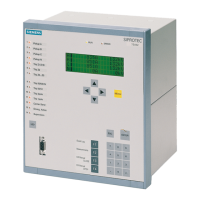NOTE
For an interaction between the automatic reclosing function (79 AR) and the control function, an extended
CFC logic is necessary. See margin heading “Close command: Directly or via Control” in the Setting Notes of
the automatic reclosing function (Section 2.15.6 Setting Notes).
Interaction with Automatic Reclosure Function (phases)
When reclosing follows, high-speed protection against faults with 67-2 or 67-3 is usually desired. If the fault
still exists after reclosing, the 67-1 or 67-TOC element will be initiated with graded tripping times, that is, the
67-2 or 67-3 element will be blocked. You can use parameter 1514 67-2 active or 1532 67-3 active
active to define whether the 67-2 or 67-3 element is influenced by a release signal of the internal or an
external automatic reclosing device or not. The setting with 79 active means that the 67-2 or 67-3
element is only released if the automatic reclosing function is not blocked. If this is not desired, the setting
always is selected so that the 67-2 or 67-3 element is always active as configured.
The integrated automatic reclosing function of 7SJ80 also provides the option to individually determine for
each overcurrent element whether tripping or blocking is to be carried out instantaneously, unaffected by the
AR with time delay (see Section 2.15 Automatic Reclosing System 79).
Interaction with Automatic Reclosing Function (ground)
If reclosing follows, high-speed and simultaneous closing in the event of a fault with 67N-2 is usually desired.
If the fault still exists after reclosing, the 67N-1 or 67N-TOC element is initiated with graded tripping times,
that is, the 67N-2 or 67N-3 element is blocked. For this purpose, parameter 1614 67N-2 active or 1632
67N-3 active is used to determine whether the 67N-2 or 67N-3 element is influenced by the release signal
of the internal or an external automatic reclosing device or not. The setting with 79 active means that the
67N- 2 or 67N-3 element is only released if the automatic reclosing function is not blocked. If this is not
desired, the setting always is selected so that the 67N-2 or 67N-3 element is always active as configured.
The integrated automatic reclosing function of 7SJ80 also provides the option to individually determine for
each overcurrent element whether tripping or blocking is to be carried out instantaneously, unaffected by the
AR with time delay (see Section 2.15 Automatic Reclosing System 79).
Settings
Addresses which have an appended “A” can only be changed with DIGSI, under “Additional Settings”.
The table indicates region-specific default settings. Column C (configuration) indicates the corresponding
secondary nominal current of the current transformer.
Addr.
Parameter C Setting Options Default Setting Comments
1501 FCT 67/67-TOC OFF
ON
OFF 67, 67-TOC Phase Time
Overcurrent
1502 67-2 PICKUP 1A 0.10 .. 35.00 A; ∞ 2.00 A 67-2 Pickup
5A 0.50 .. 175.00 A; ∞ 10.00 A
1503 67-2 DELAY 0.00 .. 60.00 sec; ∞ 0.10 sec 67-2 Time Delay
1504 67-1 PICKUP 1A 0.10 .. 35.00 A; ∞ 1.00 A 67-1 Pickup
5A 0.50 .. 175.00 A; ∞ 5.00 A
1505 67-1 DELAY 0.00 .. 60.00 sec; ∞ 0.50 sec 67-1Time Delay
1507 67-TOC PICKUP 1A 0.10 .. 4.00 A 1.00 A 67-TOC Pickup
5A 0.50 .. 20.00 A 5.00 A
1508 67 TIME DIAL 0.05 .. 3.20 sec; ∞ 0.50 sec 67-TOC Time Dial
1509 67 TIME DIAL 0.50 .. 15.00 ; ∞ 5.00 67-TOC Time Dial
1510 67-TOC Drop-out Instantaneous
Disk Emulation
Disk Emulation Drop-Out Characteristic
2.3.11
Functions
2.3 Directional Overcurrent Protection 67, 67N
SIPROTEC 4, 7SJ80, Manual 101
E50417-G1140-C343-A8, Edition 12.2017
